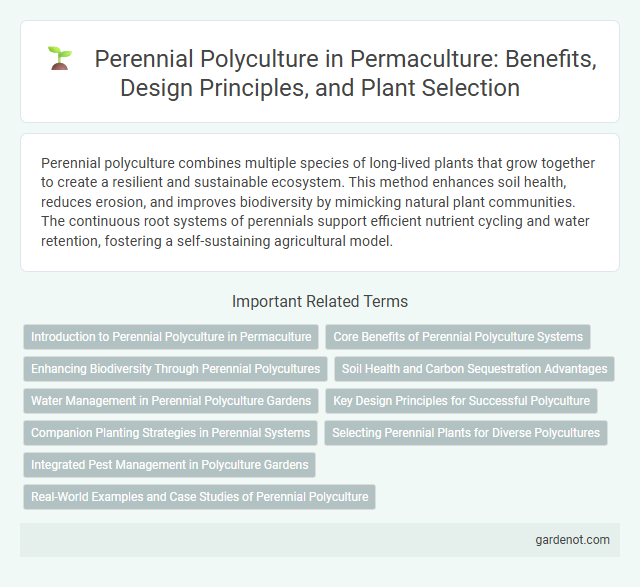Perennial polyculture combines multiple species of long-lived plants that grow together to create a resilient and sustainable ecosystem. This method enhances soil health, reduces erosion, and improves biodiversity by mimicking natural plant communities. The continuous root systems of perennials support efficient nutrient cycling and water retention, fostering a self-sustaining agricultural model.
Introduction to Perennial Polyculture in Permaculture
Perennial polyculture in permaculture integrates diverse, long-lived plant species that coexist and support each other, enhancing ecosystem resilience and soil health. This approach mimics natural ecosystems by combining fruit trees, shrubs, herbs, and ground covers to create sustainable, self-maintaining food systems. Efficient nutrient cycling, improved biodiversity, and reduced erosion are key benefits that make perennial polyculture a foundational practice in regenerative agriculture.
Core Benefits of Perennial Polyculture Systems
Perennial polyculture systems improve soil health through continuous root presence, enhancing nutrient cycling and reducing erosion. These systems increase biodiversity, fostering resilient ecosystems that better withstand pests and climate variability. Water retention and carbon sequestration are also optimized, contributing to sustainable agricultural productivity and environmental conservation.
Enhancing Biodiversity Through Perennial Polycultures
Perennial polycultures enhance biodiversity by integrating diverse plant species that establish long-lasting root systems, creating stable habitats for beneficial insects, soil microbes, and wildlife. These systems improve ecosystem resilience by mimicking natural plant communities, reducing soil erosion, and promoting nutrient cycling. Incorporating nitrogen-fixing legumes, deep-rooted shrubs, and fruiting perennials fosters complex interactions that support overall ecological health and productivity in permaculture designs.
Soil Health and Carbon Sequestration Advantages
Perennial polyculture systems enhance soil health by promoting diverse root structures that improve soil porosity, organic matter content, and microbial activity. These systems increase carbon sequestration through continuous biomass input and reduced soil disturbance, effectively capturing atmospheric carbon in stable soil organic compounds. Implementing perennial polycultures contributes to long-term ecosystem resilience and mitigates climate change impacts by maintaining high levels of soil carbon storage.
Water Management in Perennial Polyculture Gardens
Perennial polyculture gardens utilize deep-rooted plants that naturally enhance soil water retention and reduce surface runoff, promoting efficient water use. Integrating mulch layers and swales within these systems captures rainwater and directs it to plant roots, minimizing erosion and conserving moisture. These water management strategies support resilient ecosystems by maintaining consistent hydration and reducing the need for supplemental irrigation.
Key Design Principles for Successful Polyculture
Perennial polyculture relies on key design principles such as plant diversity, spatial arrangement, and ecological succession to create resilient and productive ecosystems. Integrating complementary species with varied root depths, growth habits, and nutrient requirements enhances soil health and pest resistance. Emphasizing efficient resource utilization and natural regeneration fosters sustainability and long-term system stability in permaculture landscapes.
Companion Planting Strategies in Perennial Systems
Perennial polyculture leverages companion planting strategies to enhance biodiversity, improve soil health, and increase crop resilience in sustainable systems. Integrating nitrogen-fixing plants like clover or legumes with fruit trees and perennial vegetables creates symbiotic relationships that boost nutrient cycling and pest resistance. Strategic spatial arrangement and plant diversity optimize light use and water retention while fostering beneficial insect habitats crucial for long-term ecosystem stability.
Selecting Perennial Plants for Diverse Polycultures
Selecting perennial plants for diverse polycultures involves prioritizing species that offer complementary growth habits, root structures, and nutrient requirements to enhance ecosystem resilience and productivity. Key perennial candidates include nitrogen-fixing legumes, deep-rooted taproots for soil aeration, and fruit-bearing shrubs that provide continuous yields while supporting beneficial insect habitats. Incorporating a variety of functional traits through careful species combination optimizes resource use, biodiversity, and long-term sustainability in permaculture designs.
Integrated Pest Management in Polyculture Gardens
Perennial polyculture systems enhance biodiversity and resilience by integrating multiple plant species with extended lifespans, creating habitats that support natural pest predators and reduce pest outbreaks. Integrated Pest Management (IPM) in polyculture gardens employs biological controls, habitat manipulation, and crop diversification to minimize chemical interventions and promote ecological balance. This holistic approach leverages ecological interactions, such as predator-prey relationships and companion planting, to sustainably manage pest populations in perennial polyculture environments.
Real-World Examples and Case Studies of Perennial Polyculture
Perennial polyculture systems in permaculture demonstrate enhanced biodiversity and sustainable yields, as exemplified by the temperate agroforestry practices in the Pacific Northwest, where chestnuts, hazelnuts, and understory berries coexist. Case studies from the Loess Plateau in China reveal soil restoration and increased carbon sequestration through integrated perennial crops like mulberry, jujube, and medicinal herbs. Research in Mediterranean climates highlights mixed perennial orchards combining olives, figs, and alfalfa for resilient food production and ecosystem stability.
Perennial polyculture Infographic

 gardenot.com
gardenot.com